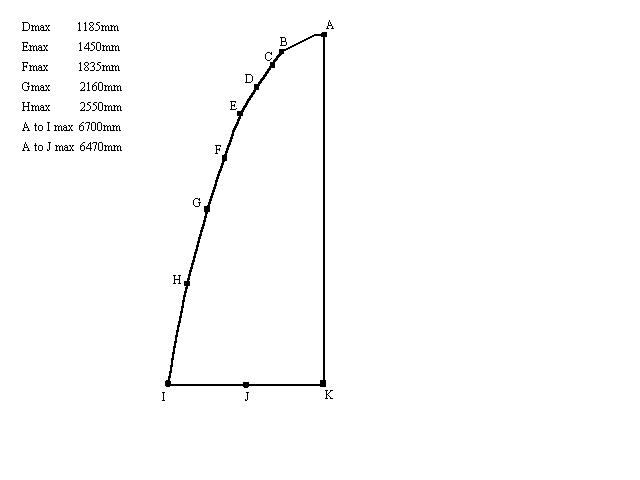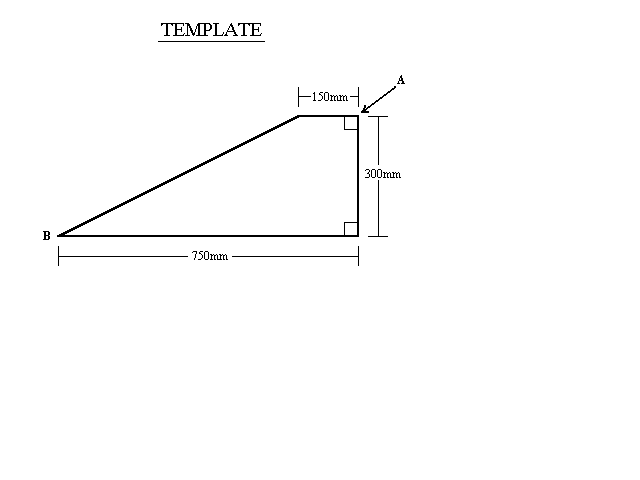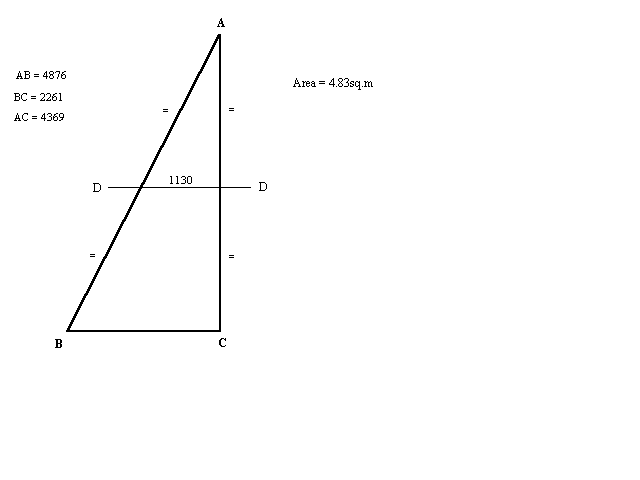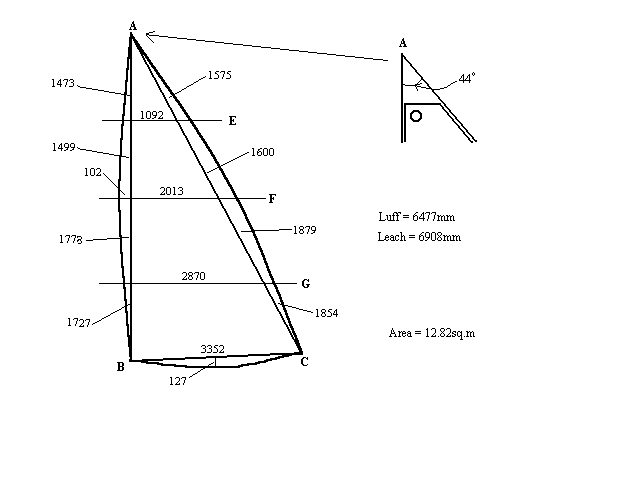| (a) Length overall | - 6096 +/-15 |
| (b) Maximum beam | - 2286 +/-13 taken at deck (station 6), excluding |
| gunwales | |
| (c) Keel centres | - 1829 +/-13 (New boats) |
Note: At the discretion of the measurer, only one hull need be measured. It is suggested that the measurer choose the hull by the toss of a coin.
Hull shall be dry when weighed and minus spars, centreboard, rudders and sheets. Weight correctors are permitted, they shall be placed against the platecase above or below the bridgedeck floor.
| (a) Frames | - 35mm x 13mm (refer Item 7) |
| (b) Keel | - 38mm x 17mm |
| (c) Chines | - 38mm x 17mm |
| (d) Inwales | - 17mm x 17mm |
| (e) Platecase beams | - Top: 76mm x 38mm Bottom: 38mm x 25mm |
| (f) Deck beams | - 51mm x 10mm |
| (g) Cockpit floor rails | - 64mm x 38mm and 32mm x 25mm |
| (h) Beams 4,6 & 9 | - Top and bottom rails: 38mm x 19mm |
| (a) Hulls | - 4mm |
| (b) Decks | - 4mm | (c) Cockpit floor | - 6mm |
The above conditions may include the use of carbon-fibre and/or kevlar.
(a) There shall be cross beams at frames 3, 4, 6, 9 and 9 ½ - 330mm aft of frame 9. Frames 4, 6 and 9 shall extend to the inside of the outer skin of each hull.
(b) Cross beams at 4, 6 and 9 shall be "BOX" section. The ply sides at cross beams 4, 6 and 9 shall be 4mm minimum thickness.
(c) Depth of cross beams:
| At Frame 4 | - 203mm +/-6mm (Main Cross Beam). |
| At Frame 6 | - 191mm +/-6mm (Fwd Cockpit Cross Beam). | At Frame 9 | - 153mm +/-6mm (Aft Cockpit Cross Beam). |
(TO BE CHECKED)
The outside of the inner stem to Frame 1 shall be a true arc of a 966mm radius with pivot point as shown on plan. Tolerance on all above dimensions shal be +/-6mm. For measuring after the hull has been skinned the spring of the keel shall be:
(TO BE CHECKED)
| (a) Length | - 7162 +/-76. |
| (b) Halyard Heights | - Jib: 5131 to 5232 (from base of mast to bottom of |
| hole of jib attachment point). The fitting which is fixed | |
| to the mast to take the jib shall not extend from the | |
| mast by more than 50mm. | |
| - Spinnaker: 6096 to 6198 (from base of mast to | |
| top of sheave). | |
| (c) Gooseneck Height | - De-restricted. |
| (d) Spinnaker Pole Fitting | - Height to be maximum of 914 from base of mast |
| (e) Minimum Weight | - 35lbs. including rigging. Note: Rigging includes |
| halyards, trapeze wires, side stays, forestay, | |
| spreaders, fittings, etc. | |
| (f) Step | - The maximum height of Mast Step is 76 above deck, |
| and aft edge of sail track shall be located on the centre | |
| line of the boat between 2460 and 2565 from the bow | |
| when the mast is in sailing position. | |
| (g) Maximum Depth | - 177 including sail track. |
| (a) Length | - 3480 maximum overall including gooseneck and fitting. |
| (b) Depth | - 105 maximum. |
Note: The 203mm radius on the leading edge of the centreplate has been de-restricted. The centreplate may be sheathed in fibreglass or carbon-fibre.
Note: Specific restrictions apply to Championship Series.
A CANCELLED sail cannot be again used in class racing without the permission of the Sailing Committee concerned, and without re-measuring by an official measurer.
(a) Sail Marking - Must be in accordance with the I.Y.R.U. rules. The Class emblem for the "Yvonne" is the capital letter "Y" which shall be located above the registration number on each side of the mainsail.
(b) Material Weight (minimum) - Imperial:
|
|
- 3.5 UK ozs |
|
|
- 4.5 UK ozs |
|
|
- 0.75 UK ozs |
These bands shall be as close as possible to square to the sail track and shall be completely around the mast.
The bands shall be either black or white and shall be selected to best contrast the background colour. There shall be no similar marking within 300mm of either measurement band.
The mainsail shall not be adjusted so as to overlap the measurement bands on the mast.
The band shall be either black or white and shall be selected to best contrast the background colour. There shall be no similar marking within 300mm of the measurement band.
The mainsail shall not be adjusted so as to overlap the measurement bands on the boom.
There is no restriction on boom length.
There shall be a minimum of 5 and maximum of 7 mainsail battens.
All battens are to removed during measuring.
Sail cloth shall be pulled just taught enough to remove wrinkles or folds along the line being measured.
With reference to drawing 28.a.1.:
Point B is defined using the measuring template, dimensions of which are shown in drawing 28.a.2. No part of the head of the sail shall extend beyond the edges of this template when point A of the template is positioned over point A of the mainsail.
Point G is defined by folding point A to point I and marking the midpoint.
Point H is defined by folding point G to point I and marking the midpoint.
Point E is defined by folding point A to point G and marking the midpoint.
Point F is defined by folding point E to point G and marking the midpoint.
Point C is defined by folding point A to point E and marking the midpoint.
Point D is defined by folding point C to point E and marking the midpoint.
Point J is defined by folding point K to point I and marking the midpoint.
The girth measurements taken at points D, E, F, G and H are to be taken from (i) the defined point on the leech, to (ii) the luff at it's closest point, and are not to exceed the lengths shown on drawing 28.a.1.
The measurements (i) point A to point I, and (ii) point A to point J, are not to exceed the lengths shown on drawing 28.a.1.
The headboard shall not extend further than 150mm from the front edge of the luff/head intersection point.


The maximum width of sail at DD is 1130mm. The luff, leach and foot shall be smooth curves.
BATTENS: Headboards not permitted, battens de-restricted.

(ii) Mid-girth not to exceed 3500mm.
(iii) Base of mast to top of halyard sheave bearing not to exceed 7100mm.
(iv) Front of bows (measured from mid-point between the two bows) to front of pole tack sheave bearing not to exceed 1800mm.
(v) Spinnaker pole may be fixed or retractable.
Lay sail flat on this plan with all wrinkles removed (bolt ropes may need tension to achieve this). The Head Tack, Clew, Leach and Luff must all lie inside curved lines AB, AC and CB.
The luff, leach and foot shall be smooth curves.
BATTENS: Minimum of five and maximum of seven, excluding headboard.

